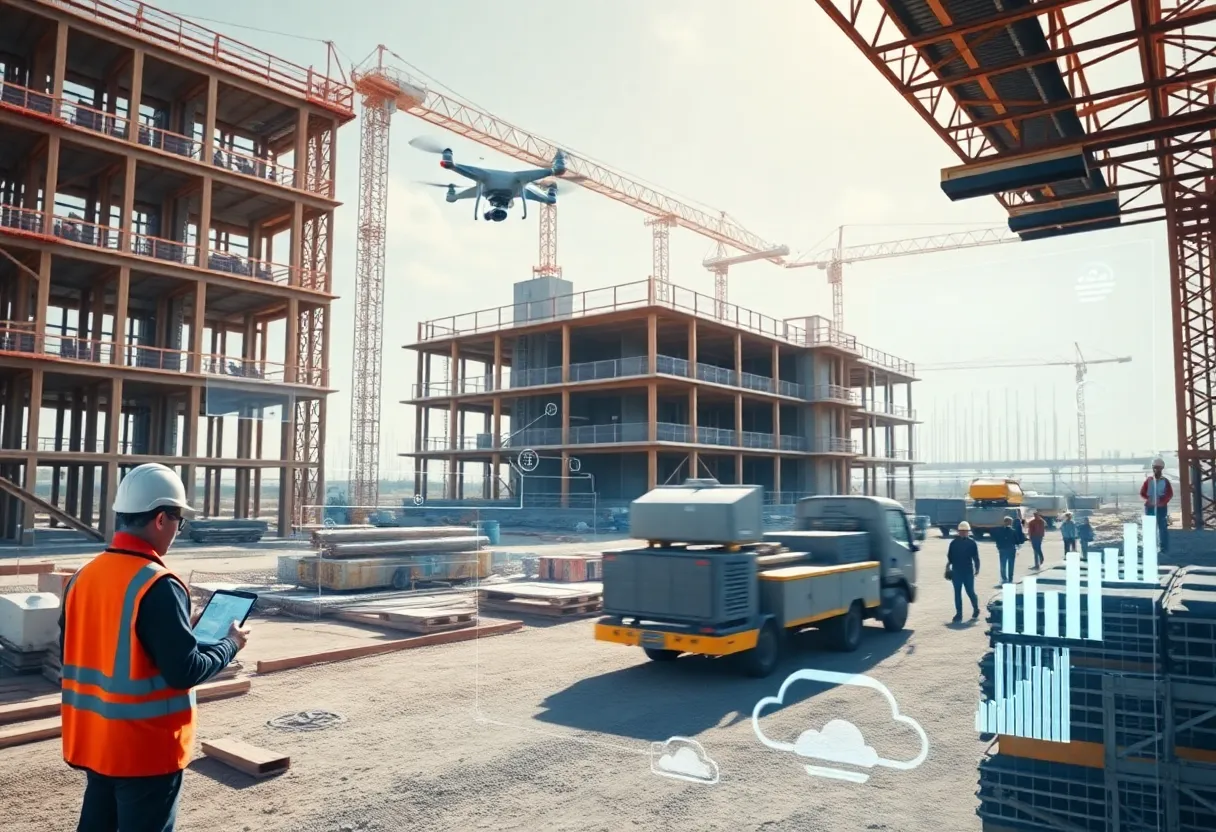Global, October 6, 2025
News Summary
A market forecast reveals rapid adoption of BIM, AI and IoT across architecture, engineering, construction and operations. BIM is evolving from visualization into a multi-dimensional platform that integrates scheduling, cost, sustainability and maintenance data while feeding from real-time IoT to create digital twins. Firms report faster clash resolution, reduced rework and improved collaboration, though interoperability costs, cultural change and training remain barriers. Examples show large reductions in change orders and materials waste. Vendors are consolidating around lifecycle platforms even as standards like ISO 19650 and openBIM work to close data gaps and improve long-term asset management.
Construction Project Management Software Outlook to 2033: BIM, AI, IoT Drive Change as Interoperability and Culture Remain Hurdles
The market for construction project management software is moving quickly as building teams add BIM, AI, and IoT into everyday workflows. The most urgent trends are tighter digital coordination, more use of sensor data for operations, and rising concern over the cost of making different tools work together. The report and materials behind this coverage highlight practical gains on project quality and long-term operations while noting barriers in standards, skills, and security.
Top-line findings and reference details
Report/press-release title referenced: Construction Project Management Software Market Size, Future Growth and Forecast 2033. All content on this site: Copyright © 2025 Elsevier B.V., its licensors, and contributors. Autodesk article update date shown: September 9, 2024.
Why BIM is central now
Building information modeling (BIM) is described as a digital platform, a visualization tool, and a way of working in the AECO (architecture, engineering, construction, operations) industry. Teams at architecture firms, engineering firms, construction firms, operations and maintenance specialists, and building owners use BIM to organize design and construction data and to tackle fragmentation and inefficiencies that have long plagued the sector.
At its core BIM creates a shared, continually updated 3D model that serves as a single source of truth. That model improves visualization, helps decision-making, and supports resource planning across all phases of a project. Multi-dimensional BIM links scheduling, cost, sustainability, and maintenance data so teams can see time, money, carbon, and operations together.
Real-world benefits and examples
BIM reduces repetitive email chains and lowers the number of RFIs. Coordination tools can generate reports and metrics automatically and send them to the right team members. Clash detection and other automation reduce rework and cut risk during design and construction. For one high-rise project in Beijing, engineers achieved an 80% reduction in change orders compared to similar projects by using clash detection workflows.
Digital twins built with BIM and sensor feeds can monitor elevators, energy use, and water consumption in real time. A landmark tower in Switzerland used a BIM digital twin with Revit and BIM 360 during design and operations. Other case studies show large savings in embodied carbon and time when teams used reality capture and BIM tools to guide adaptive reuse work.
Technology mixing and new tools
The list of technologies used now includes CAD/CAM software, game engines for richer visualization, AR/VR overlays on site, reality capture and photogrammetry, drone imagery, and AI/ML tools that flag safety issues or predict schedule drift. Examples include platforms that convert Revit models into bills of materials, AR guides that lay digital plans over real sites, and AI that can analyze imagery to identify risk.
Standards, interoperability, and cost friction
Standards have moved from national guides to international protocols; one common evolution cited was the UK Standard 1192 evolving into ISO 19650 in 2018. Despite that, interoperability problems remain. A facilities management study found lack of interoperability costs building owners billions annually. Project teams must still budget for hardware, software, training, and customization, and they should expect process-change costs when rolling out BIM.
People, process, and the slow digital curve
The construction sector has seen productivity decline since the 1990s and remains one of the least digitalized sectors of the economy. Large construction projects typically take about 20% longer to finish and run about 80% over budget on average, according to a cited study. Adoption of BIM and other digital tools requires cultural change, clear roles, and targeted training. Start-ups of BIM programs are usually recommended on projects already underway rather than brand-new projects to limit disruption.
Costs, ROI, and security
Measuring BIM ROI is difficult because many benefits are preventive and spread across team members. Reported returns include faster completion, lower cost, higher quality, new services, and better staff retention. Security remains a concern: current security tools exist but are not yet fully adapted to BIM’s needs. Encryption and blockchain are potential approaches to protect model data as BIM systems become more connected.
Corporate and vendor notes in the materials
Vendor platforms referenced across the materials include a range of CAD, BIM, and cloud tools as part of everyday project workflows. One software group in the documents positions an OPEN BIM approach and lists offices, leadership roles, historical milestones, acquisitions, and foundations tied to industry research and philanthropy. Contact and office addresses for that group and other service providers are included in the source materials.
Implementation advice and next steps
The practical guidance in the materials recommends auditing current processes, defining measurable objectives, piloting new tools on in-progress projects, and phasing rollouts to spread upfront costs. Recommended mitigation steps include SaaS licensing to manage cash flow, middleware to bridge systems, training to reduce staff resistance, and cybersecurity measures to protect data.
Bottom line
The path ahead ties better-built digital models to long-term operations and lower lifecycle cost. Adoption is expanding, but teams must plan for interoperability costs, cultural shifts, and security gaps. The technologies are maturing and are already changing how many projects are planned, built, and operated.
FAQ
Q: What is the report title?
A: Report/press-release title referenced: Construction Project Management Software Market Size, Future Growth and Forecast 2033.
Q: What copyright note appears in the materials?
A: All content on this site: Copyright © 2025 Elsevier B.V., its licensors, and contributors.
Q: When was the Autodesk article update date shown?
A: Autodesk article update date shown: September 9, 2024.
Q: How is BIM described in the materials?
A: Building information modeling (BIM) is described as a digital platform, a visualization tool, and a way of working in the AECO (architecture, engineering, construction, operations) industry.
Q: What recommendation is given for starting BIM implementation?
A: Recommendation: Start BIM implementation on projects already underway rather than brand-new projects.
{
“@context”: “https://schema.org”,
“@type”: “FAQPage”,
“mainEntity”: [
{
“@type”: “Question”,
“name”: “What is the report title?”,
“acceptedAnswer”: {
“@type”: “Answer”,
“text”: “Report/press-release title referenced: Construction Project Management Software Market Size, Future Growth and Forecast 2033.”
}
},
{
“@type”: “Question”,
“name”: “What copyright note appears in the materials?”,
“acceptedAnswer”: {
“@type”: “Answer”,
“text”: “All content on this site: Copyright © 2025 Elsevier B.V., its licensors, and contributors.”
}
},
{
“@type”: “Question”,
“name”: “When was the Autodesk article update date shown?”,
“acceptedAnswer”: {
“@type”: “Answer”,
“text”: “Autodesk article update date shown: September 9, 2024.”
}
},
{
“@type”: “Question”,
“name”: “How is BIM described in the materials?”,
“acceptedAnswer”: {
“@type”: “Answer”,
“text”: “Building information modeling (BIM) is described as a digital platform, a visualization tool, and a way of working in the AECO (architecture, engineering, construction, operations) industry.”
}
},
{
“@type”: “Question”,
“name”: “What recommendation is given for starting BIM implementation?”,
“acceptedAnswer”: {
“@type”: “Answer”,
“text”: “Recommendation: Start BIM implementation on projects already underway rather than brand-new projects.”
}
}
]
}
Key features table
| Feature | What it does | Why it matters |
|---|---|---|
| BIM 3D Model | Holds geometry and linked metadata for design and construction | Serves as a shared source of truth to reduce errors and emails |
| 4D/5D/6D/7D BIM | Integrates time, cost, sustainability, and maintenance into models | Helps plan schedules, budgets, carbon targets, and operations |
| Clash Detection | Finds conflicting elements before construction | Reduces rework, change orders, and schedule delays |
| Digital Twin + IoT | Feeds sensor data into live models for operations | Optimizes energy, maintenance, and lifecycle cost |
| Reality Capture / AR | Brings site photos and scans into models and overlays | Improves site verification, progress tracking, and safety |
| AI / ML tools | Automatically spot risk, generate takeoffs, and classify imagery | Speeds decisions and highlights safety or cost issues early |
| Standards & Interoperability | Common protocols like ISO 19650 guide data exchange | Reduces integration costs and protects long-term data use |
Deeper Dive: News & Info About This Topic
Additional Resources
- ScienceDirect: Article S0926580520310219
- Wikipedia: Building information modeling
- Autodesk: BIM — Building Information Modeling
- Google Search: BIM building information modeling
- Nemetschek Group: About Us
- Google Scholar: Nemetschek openBIM
- Indian Infrastructure: Building efficiency — Advanced technologies (Feb 5, 2025)
- Encyclopedia Britannica: Building information modeling
- Appinventiv: Digital transformation in construction
- Google News: BIM construction digital transformation
Author: Construction CA News
The CALIFORNIA STAFF WRITER represents the experienced team at constructioncanews.com, your go-to source for actionable local news and information in California and beyond. Specializing in "news you can use," we cover essential topics like product reviews for personal and business needs, local business directories, politics, real estate trends, neighborhood insights, and state news affecting the area—with deep expertise drawn from years of dedicated reporting and strong community input, including local press releases and business updates. We deliver top reporting on high-value events such as the Rose Parade, Coachella, Comic-Con, and the California State Fair. Our coverage extends to key organizations like the California Building Industry Association and Associated General Contractors of California, plus leading businesses in technology and entertainment that power the local economy such as Apple and Alphabet. As part of the broader network, including constructionnynews.com, constructiontxnews.com, and constructionflnews.com, we provide comprehensive, credible insights into the dynamic landscape across multiple states.




